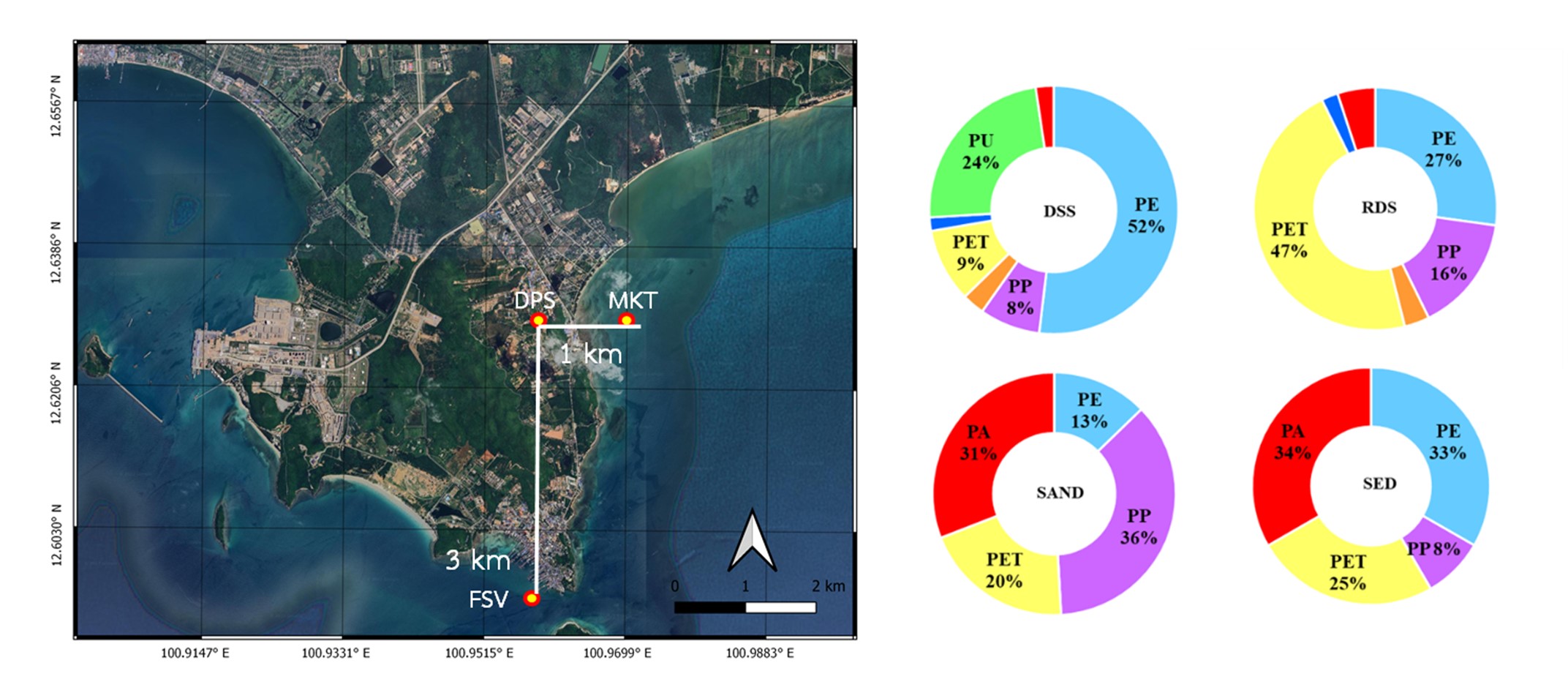Prevalence of Microplastics in Coastal Area of Samae San, Thailand and Its Possible Source
Main Article Content
Abstract
This research explored the abundance, morphology, and polymer composition of microplastics (MPs) in various environmental samples within the Samae San subdistrict involving surface soil nearby the dumping site, road dust soil, beach sand and sediment in the area with distinct land- based activities. Dumping site soil exhibited the highest concentration in items per kg of dry weight at 93,734.3, followed by road dust soil (573.0 ± 583.7), beach sand (99.8 ± 75.3), and sediment (83.1 ± 50.4). Morphological traits revealed similarities between transparent fiber-shaped particles in beach sands and sediment, and those in nearby road dust soil, while green sheet-shaped particles dominated in dumping site soil. Predominant polymer types included PE, PET, and PP, associated with daily plastics, fishing gear, and fishing nets. In beach sand and sediment samples, transparent polyamide (nylon) fibers shaped like microplastics (MPs) were notably observed, as it is a common material used in fishing nets. Cluster analysis indicated a resemblance between MPs in beach sand, sediment, and nearby road dust soil, implying that plastic debris, comprising single-use plastics and fishing equipment, could be a potential source of MPs in coastal areas.
Article Details

This work is licensed under a Creative Commons Attribution-NonCommercial 4.0 International License.
Published articles are under the copyright of the Applied Environmental Research effective when the article is accepted for publication thus granting Applied Environmental Research all rights for the work so that both parties may be protected from the consequences of unauthorized use. Partially or totally publication of an article elsewhere is possible only after the consent from the editors.
References
PlasticEurope, Plastics - the facts WEB-2020. 2020.
Inanc, B., et al., Development of a database of landfills and dump sites in Asian countries. Journal of Material Cycles and Waste Management, 2004. 6(2).
Gewert, B., M.M. Plassmann, and M. MacLeod, Pathways for degradation of plastic polymers floating in the marine environment. Environ Sci Process Impacts, 2015. 17(9): p. 1513-21.
K, M.B., et al., Spatial distribution of microplastic concentration around landfill sites and its potential risk on groundwater. Chemosphere, 2021. 277: p. 130263.
Puthcharoen, A., Determination of Microplastics in Soil and Leachate from the Landfills Thai Environmental Engineering, 2019. 33: p. 39-46.
Tun, T.Z., et al., Microplastics in dumping site soils from six Asian countries as a source of plastic additives. Sci Total Environ, 2022. 806(Pt 4): p. 150912.
Turner, A. and M. Filella, Hazardous metal additives in plastics and their environmental impacts. Environ Int, 2021. 156: p. 106622.
Leon, V.M., et al., PAHs, pesticides, personal care products and plastic additives in plastic debris from Spanish Mediterranean beaches. Sci Total Environ, 2019. 670: p. 672-684.
Deng, H., et al., PAEs and PBDEs in plastic fragments and wetland sediments in Yangtze estuary. J Hazard Mater, 2021. 409: p. 124937.
PCD. Thailand's Roadmap on Plastic Waste Management 2018 - 2030. 2020; Available from: https://www.pcd.go.th/wp-content/uploads/2020/05/pcdnew-2020-05-27_06-47-53_174751.pdf.
Bajt, O., From plastics to microplastics and organisms. FEBS Open Bio, 2021. 11(4): p. 954-966.
Jualaong, S., et al., Type and Distribution of Microplastics in Beach Sediment along the Coast of the Eastern Gulf of Thailand. Journal of Marine Science and Engineering, 2021. 9(12).
Chinfak, N., et al., Abundance, composition, and fate of microplastics in water, sediment, and shellfish in the Tapi-Phumduang River system and Bandon Bay, Thailand. Science of The Total Environment, 2021. 781.
Sukhsangchan, R., et al., Suspended microplastics during a tidal cycle in sea-surface waters around Chao Phraya River mouth, Thailand. ScienceAsia, 2020. 46(6).
Thushari, G.G., S. Chavanich, and A. Yakupitiyage, Coastal debris analysis in beaches of Chonburi Province, eastern of Thailand as implications for coastal conservation. Mar Pollut Bull, 2017. 116(1-2): p. 121-129.
Kitahara, K.I. and H. Nakata, Plastic additives as tracers of microplastic sources in Japanese road dusts. Sci Total Environ, 2020. 736: p. 139694.
Mon, E.E., et al., Monitoring of microplastics in road dust samples from Myanmar and Taiwan. Environmental Monitoring and Contaminants Research, 2022. 2(0): p. 112-119.
Bissen, R. and S. Chawchai, Microplastics on beaches along the eastern Gulf of Thailand - A preliminary study. Mar Pollut Bull, 2020. 157: p. 111345.
Wang, Y., et al., Occurrence and distribution of microplastics in surface sediments from the Gulf of Thailand. Mar Pollut Bull, 2020. 152: p. 110916.
Peng, G., et al., Microplastics in sediments of the Changjiang Estuary, China. Environ Pollut, 2017. 225: p. 283-290.
Mathalon, A. and P. Hill, Microplastic fibers in the intertidal ecosystem surrounding Halifax Harbor, Nova Scotia. Mar Pollut Bull, 2014. 81(1): p. 69-79.
Qiu, Q., et al., Occurrence of microplastics in the coastal marine environment: First observation on sediment of China. Mar Pollut Bull, 2015. 98(1-2): p. 274-80.
Tun, T.Z., et al., Polymer types and additive concentrations in single-use plastic products collected from Indonesia, Japan, Myanmar, and Thailand. Sci Total Environ, 2023. 889: p. 163983.

